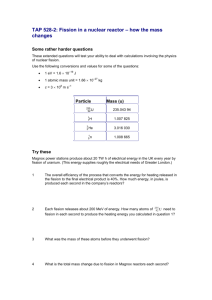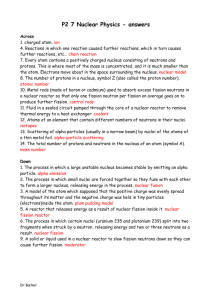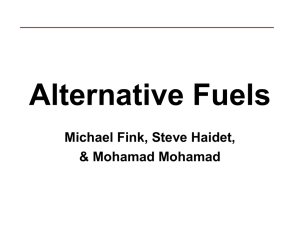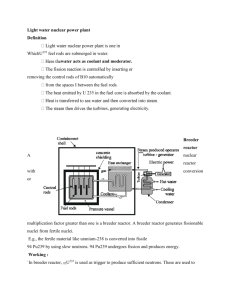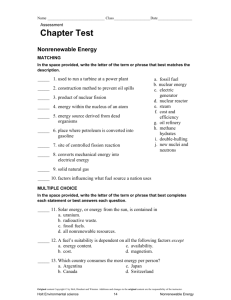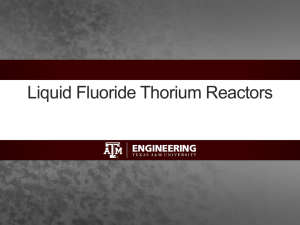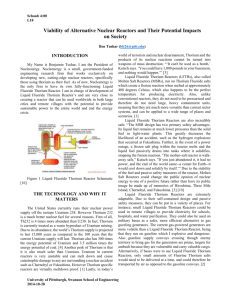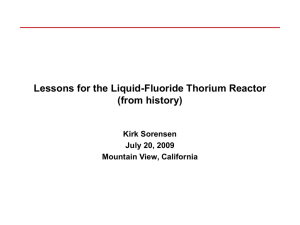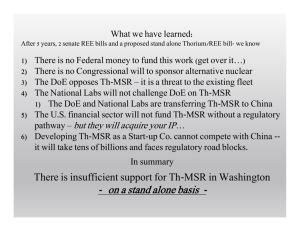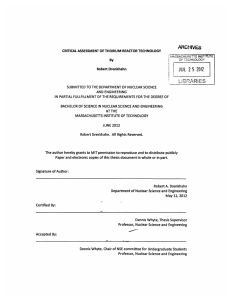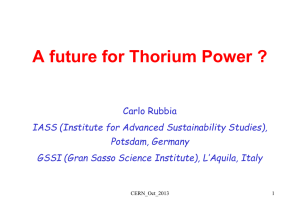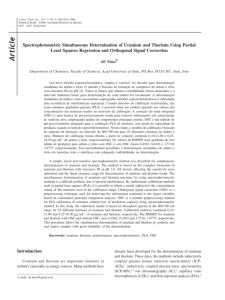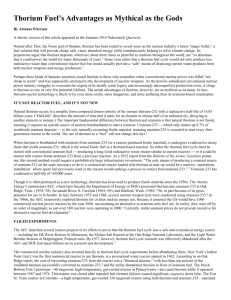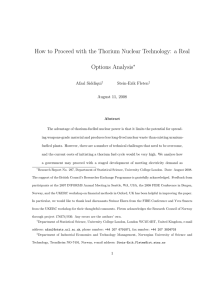Thorium: Is It the Better Nuclear Fuel?
advertisement
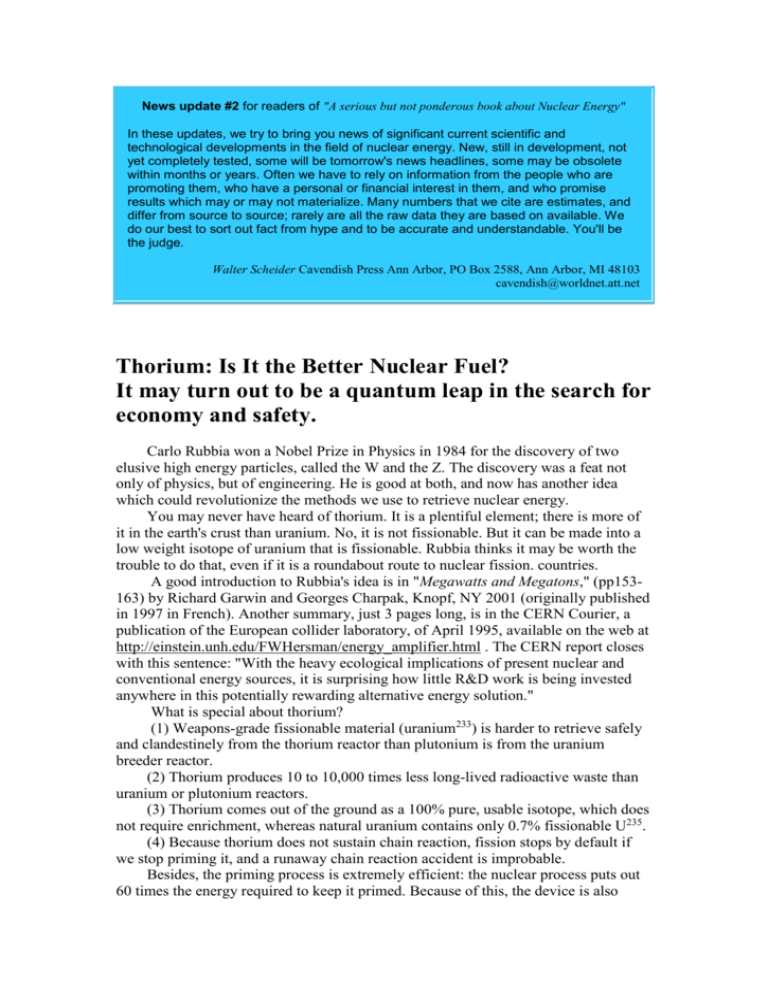
News update #2 for readers of "A serious but not ponderous book about Nuclear Energy" In these updates, we try to bring you news of significant current scientific and technological developments in the field of nuclear energy. New, still in development, not yet completely tested, some will be tomorrow's news headlines, some may be obsolete within months or years. Often we have to rely on information from the people who are promoting them, who have a personal or financial interest in them, and who promise results which may or may not materialize. Many numbers that we cite are estimates, and differ from source to source; rarely are all the raw data they are based on available. We do our best to sort out fact from hype and to be accurate and understandable. You'll be the judge. Walter Scheider Cavendish Press Ann Arbor, PO Box 2588, Ann Arbor, MI 48103 cavendish@worldnet.att.net Thorium: Is It the Better Nuclear Fuel? It may turn out to be a quantum leap in the search for economy and safety. Carlo Rubbia won a Nobel Prize in Physics in 1984 for the discovery of two elusive high energy particles, called the W and the Z. The discovery was a feat not only of physics, but of engineering. He is good at both, and now has another idea which could revolutionize the methods we use to retrieve nuclear energy. You may never have heard of thorium. It is a plentiful element; there is more of it in the earth's crust than uranium. No, it is not fissionable. But it can be made into a low weight isotope of uranium that is fissionable. Rubbia thinks it may be worth the trouble to do that, even if it is a roundabout route to nuclear fission. countries. A good introduction to Rubbia's idea is in "Megawatts and Megatons," (pp153163) by Richard Garwin and Georges Charpak, Knopf, NY 2001 (originally published in 1997 in French). Another summary, just 3 pages long, is in the CERN Courier, a publication of the European collider laboratory, of April 1995, available on the web at http://einstein.unh.edu/FWHersman/energy_amplifier.html . The CERN report closes with this sentence: "With the heavy ecological implications of present nuclear and conventional energy sources, it is surprising how little R&D work is being invested anywhere in this potentially rewarding alternative energy solution." What is special about thorium? (1) Weapons-grade fissionable material (uranium233) is harder to retrieve safely and clandestinely from the thorium reactor than plutonium is from the uranium breeder reactor. (2) Thorium produces 10 to 10,000 times less long-lived radioactive waste than uranium or plutonium reactors. (3) Thorium comes out of the ground as a 100% pure, usable isotope, which does not require enrichment, whereas natural uranium contains only 0.7% fissionable U235. (4) Because thorium does not sustain chain reaction, fission stops by default if we stop priming it, and a runaway chain reaction accident is improbable. Besides, the priming process is extremely efficient: the nuclear process puts out 60 times the energy required to keep it primed. Because of this, the device is also called, (quite inappropriately) an "Energy Amplifier." Naturally occurring 232 thorium is in the form of the stable isotope, 90Th . Notice that thorium is just two places removed on the periodic table from Uranium. In a sequence of nuclear processes exactly like those by which the non-fissionable isotope, 92U238 is bumped up through Neptunium to Plutonium, 94Pu239, Thorium can be bumped up to a light weight isotope of Uranium, 92U233. (See p 135, Eq 15.01 and 15.02 of "A serious but not ponderous book about Nuclear Energy".) In each case, a non-fissionable isotope is converted to a fissionable one. Plutonium, while highly radioactive, can be shielded and concealed for shipping and storage, because the alpha rays that it emits do not penetrate lead. On the other hand, uranium233, the weapons-grade material that could be recovered from the thorium reactor, can not be as easily concealed. U233 is almost inextricably accompanied by 0.1% of U232, which, after a series of dissociations (to thallium208) emits gamma rays that penetrate everything. Here is the thorium sequence in the Rubbia reactor: A neutron is captured by 232 Th , which makes it 90Th233. 90 232 90Th + 1 0n 233 90Th -> [1] Thorium-233 spontaneously emits a beta particle (an electron from the nucleus, see p 173), leaving behind one additional proton, and one fewer neutron. ("...Nuclear Energy" p134) This is called "beta decay." 233 90Th -> 233 91Pa + ß [2] The element with 91 protons is Protactinium (Pa). The isotope 91PA233 also undergoes beta decay, 233 91Pa -> 233 92U + ß [3] The U233 isotope that is produced in step [3] is fissionable, but has fewer neutrons than its heavier cousin, Uranium-235, and its fission releases only 2 neutrons, not 3. 233 92U + 1 0n -> fission fragments + 20n1 [4] If this sequence [1 through 4] is to replicate itself, it would require one neutron to generate the next U233 nucleus [1– 3] and another would be required to induce the U233 nucleus to fission [4]. A chain reaction, then, could occur only with 100% utilization of the 2 neutrons emitted in [4]. 100% utilization means none can be allowed to get away, an ideal that can not occur in practice. With 98% utilization, the generation ratio (p 87-93) would be 0.98, and the half-life of the decline of the number of fissions per generation would be 50 generations. (1000 fissions in the zeroth generation would decline to 1000/e, or 368, fissions in 50 generations.) This means that by itself, the fission process would die out very quickly. With a steady supply of "priming" neutrons, one can obtain, on the average, 50 new fissions from each priming neutron. There is, of course, a cost in providing the priming neutrons. But because the energy cost of the priming neutron is about 30 to 60 times less than the energy yield of the fissions it triggers, there is a net gain of energy of about 30 to 60. This is why it is called an Energy Amplifier (EA). The priming neutrons are emitted in a process called "spallation," which is the induced splitting of an otherwise non-fissionable large nucleus. In the EA, a proton beam impinges on lead, the high energy protons splitting lead nuclei, leading to release of neutrons. In Rubbia's design, the molten lead doubles also as primary coolant. The diagram at the left shows the proposed arrangement, most of it below ground level. High energy protons emerge through a window in the tip of the proton beam tube inside the core. Protons split lead nuclei, with neutrons emitted into the core. The molten lead carries nuclear heat upward by convection. Pumping is required only in the secondary coolant loop, which carries the heat to where steam is made for the turbines. All other circulation is convection-driven, with no moving machinery. The lead and air circulation is guided along partitions that are not shown. The lead vessel is nearly 30 meters long and 6 meters in diameter, and contains 10,000 tons of lead. Control rods are not needed, either to regulate energy production or to stop fission in an emergency, because the fission rate is determined by the proton accelerator. If the accelerator stops sending protons, fission stops almost instantly. In an emergency, the proton accelerator can be switched off by a trigger signal, or it can be shut off automatically if overheating causes the expanding lead to overflow into the accelerator. Once fission is stopped, there is still the heat released from radioactive fission fragments that were produced before the shut-down. Although this rate of heat generation is a small fraction of that during normal operation of the reactor, the aftershutdown heat can accumulate rapidly if it is not removed (p 208). In the conventional uranium reactor this heat can be sufficient to melt the core and the bottom of the containment. There is no reason to believe that the prevalence of short-lived radioactive fission fragments (after fission is stopped) will be much different in the Rubbia reactor from that in uranium 235 reactors (p 208). But the EA is undoubtedly a safer reservoir for the after-shutdown heat than the conventional reactor, because it is filled with heat absorbing material (lead) that does not leak, does not require pumping to distribute the heat evenly, and will not boil away or make bubbles, as water does. Simple calculations suggest that the lead in this reactor has sufficient heat capacity to keep the temperature in the reactor below 1300oC even in the worst case, if the cooling system shuts down completely and no heat is removed from the reactor. The radioactive waste from the thorium reactor contains vastly less long-lived radioactive material than that from conventional reactors. In particular, plutonium is completely absent absent from the thorium reactor's waste. While the radioactivity during the first few days is likely to be similar to that in conventional reactors, there is at least a ten-fold reduction of radioactivity in the waste products after 100 years, and a 10,000 fold reduction after 500 years. From a waste storage point of view, this is a significant advantage. It is certainly premature to celebrate this technology yet. Much of the feasibility data is from small scale tests and from simulations. There are technical challenges that will have to be overcome. One of these is to find a containment material that does not have the nasty tendency that steel has to dissolve in molten lead. An encouraging fact is that so far, the simulations and tests have supported the theoretical predictions, which is a testament to the engineering savvy of Carlo Rubbia. In addition to the CERN group, several laboratories in the US, Japan, and Russia are working on various aspects of the EA technology. To NUCLEAR ENERGY UPDATE #1 Back to NUCLEAR ENERGY BOOK home page Back to BOOKS home page Back to Web site HOME page. cavendishscience.org

